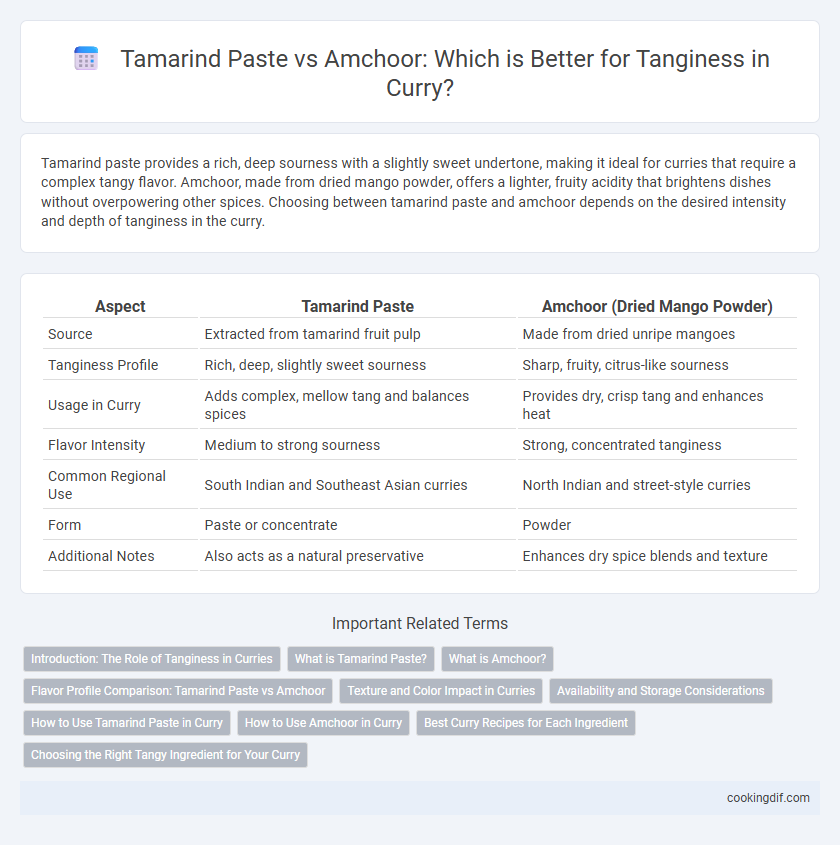Tamarind paste provides a rich, deep sourness with a slightly sweet undertone, making it ideal for curries that require a complex tangy flavor. Amchoor, made from dried mango powder, offers a lighter, fruity acidity that brightens dishes without overpowering other spices. Choosing between tamarind paste and amchoor depends on the desired intensity and depth of tanginess in the curry.
Table of Comparison
| Aspect | Tamarind Paste | Amchoor (Dried Mango Powder) |
|---|---|---|
| Source | Extracted from tamarind fruit pulp | Made from dried unripe mangoes |
| Tanginess Profile | Rich, deep, slightly sweet sourness | Sharp, fruity, citrus-like sourness |
| Usage in Curry | Adds complex, mellow tang and balances spices | Provides dry, crisp tang and enhances heat |
| Flavor Intensity | Medium to strong sourness | Strong, concentrated tanginess |
| Common Regional Use | South Indian and Southeast Asian curries | North Indian and street-style curries |
| Form | Paste or concentrate | Powder |
| Additional Notes | Also acts as a natural preservative | Enhances dry spice blends and texture |
Introduction: The Role of Tanginess in Curries
Tanginess in curries enhances depth and balances rich, spicy flavors, creating a well-rounded taste profile. Tamarind paste delivers a deep, sweet-sour flavor with fruity undertones, commonly used in South Indian and Southeast Asian dishes. Amchoor, derived from dried green mangoes, offers a sharp, citrusy tang, ideal for adding bright acidity without moisture.
What is Tamarind Paste?
Tamarind paste, extracted from the pulp of the tamarind fruit, provides a rich, tangy flavor that enhances the complexity of curries with its slightly sweet and sour notes. It contains natural acids that deliver a smooth, mellow sourness, making it a key ingredient in many South Asian and Southeast Asian dishes. Unlike amchoor, which is made from dried green mangoes and offers a sharper, more fruity tang, tamarind paste brings a deep, fermented tartness that works well in stews, chutneys, and marinades.
What is Amchoor?
Amchoor, also known as dried mango powder, is a tangy spice made from unripe green mangoes that are sun-dried and ground into a fine powder. It imparts a fruity sourness to curry dishes, making it a popular ingredient in Indian cuisine for adding acidity and enhancing flavors without adding moisture. Unlike tamarind paste, which offers a rich, slightly sweet tartness, amchoor provides a sharper, more citrus-like tang that brightens the overall taste profile of the curry.
Flavor Profile Comparison: Tamarind Paste vs Amchoor
Tamarind paste delivers a rich, deep sourness with fruity and slightly sweet undertones, enhancing curry with a complex tangy depth. Amchoor, made from dried green mangoes, offers a lighter, sharper acidity and a fruity citrus flavor that brightens dishes without overpowering. Choosing tamarind paste provides a more intense and rounded sourness, while amchoor contributes a fresh, zesty tang ideal for delicate flavor balance.
Texture and Color Impact in Curries
Tamarind paste adds a rich, dark brown hue and a smooth, thick texture to curries, intensifying their tanginess with a slightly sweet undertone. Amchoor, derived from dried mango powder, imparts a lighter, powdery texture and a pale yellow color, offering a sharper, more astringent tang. The choice between tamarind paste and amchoor significantly influences the visual appeal and mouthfeel, shaping the overall flavor profile of the curry.
Availability and Storage Considerations
Tamarind paste is widely available in most grocery stores and can be stored in the refrigerator for up to six months, maintaining its tangy flavor and smooth texture. Amchoor, a powdered dried mango product, is less common and often found in specialty or Indian markets, with a longer shelf life of about one year when kept in a cool, dry place. Both ingredients offer distinctive tanginess, but tamarind paste requires refrigeration after opening, while amchoor's dry form allows easier storage without refrigeration.
How to Use Tamarind Paste in Curry
Tamarind paste imparts a rich, savory tanginess to curry, enhancing depth with its unique sour and slightly sweet flavor profile. To use tamarind paste in curry, dissolve a small amount in warm water and stir it into the dish during the simmering stage to evenly distribute its acidity. Unlike amchoor, which is a dry mango powder providing a sharp citrus tang, tamarind paste delivers a smoother, more complex sour note, ideal for balancing robust spices in traditional Indian and Southeast Asian curry recipes.
How to Use Amchoor in Curry
Amchoor, a tangy mango powder, adds a subtle fruity acidity to curry without altering its color, unlike tamarind paste which imparts a darker hue. To use amchoor in curry, sprinkle it during the final stages of cooking or just before serving to preserve its vibrant tanginess and fruity notes. It pairs exceptionally well with lentil-based curries and vegetable dishes, enhancing the flavor profile with a bright, citrusy tang.
Best Curry Recipes for Each Ingredient
Tamarind paste delivers a rich, deep sourness that enhances curries like South Indian sambar or Thai shrimp curry with its complex fruity tang. Amchoor powder provides a lighter, citrusy acidity ideal for North Indian dishes such as chana masala and aloo curry, imparting subtle tartness without overpowering spices. Selecting tamarind paste or amchoor depends on the desired depth of tanginess and regional flavor profile to achieve the best curry recipes for each ingredient.
Choosing the Right Tangy Ingredient for Your Curry
Tamarind paste offers a rich, slightly sweet sourness that deepens curry flavors with its fruity complexity, while amchoor powder provides a dry, sharp tang derived from dried green mangoes, imparting brightness without added moisture. Selecting tamarind paste enhances thicker, saucier curries requiring a mellow acidity, whereas amchoor suits lighter dishes or spice blends where a crisp, vibrant acidity is desired. Understanding these distinct flavor profiles helps achieve the perfect balance of tanginess tailored to your curry's texture and regional spice preferences.
Tamarind paste vs amchoor for tanginess Infographic

 cookingdif.com
cookingdif.com